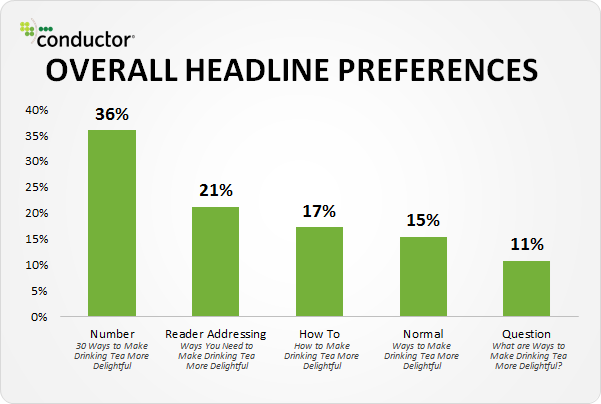How to Write a Catchy Article Title? 10 Tips to Follow

An article title is the first and frequently the last thing a potential reader sees. In fact, users don’t even notice run-of-the-mill titles when scrolling the search results, Google News or social media. If you don’t make a positive first impression, you may not have another chance – so check out how to write catchy article titles and attract users for longer.
Table of contents:
- Article titles – why are they important?
- How to write a catchy article title?
- 10 tips on how to write the title of an article
- Take advantage of our love for numbers
- Emphasize the unique value you give to users
- Use memorable phrases
- Consider your target audience
- Address the recipient, speak directly
- Ask questions
- Come up with several titles before you choose the one
- Use keywords
- Don’t let your market rivals outdo you
- Make a checklist
- Catchy article titles- examples you should know (and use)
- Don’ts when creating article titles
- Examples of quality article titles
- Exercise for you: one article, 5 different titles
- Last but not least, 5 pillars of a good article title
From a marketing point of view, writing a catchy article title is one of the most important skills a good copywriter needs to have. After all, nobody will read even the best 2,000-word blog post, if its title resembles a scientific dissertation rather than an enticing catchy online article.
Taking into consideration website and store owners, as well as experienced and aspiring copywriters, we’ve created this post to show you how to write the title of an article that is not only SEO-friendly but also reader-friendly.
You’ll also learn what to do once you catch the user’s attention – after all, you don’t want to increase the number of visits to your site at the expense of a growing bounce rate, do you?
Article titles – why are they important?
Let’s start with a few words explaining why it’s worth creating catchy article titles.
What about the statistics?
- According to CopyBlogger, on average 8 out of 10 people read titles of articles they come across, but only 2 out of 10 read entire articles. This means that even if a user sees your post, they won’t necessarily be interested in it. This drop in the numbers can be compared to the difference between views and clicks measured by Google Search Console: the latter ones will always be smaller, but there are a bunch of things you can do to make the difference less noticeable.
- David Ogilvy also referred to the 8/10 rule and stated that “on average, five times as many people read only the title, not the full text. That’s why when you write a header, you spend 80 cents of your dollar” – that’s how much titles matter compared to the entire content!
- Peter Coachley, who used to work with UpWorthy, found that the exact same content with different titles can generate up to a 500% difference in traffic. He also repeatedly reminds us that users don’t wake up wanting to read about what we write – a catchy article title is a chance to attract a person who has a thousand other things to do. In fact, he stated that it’s the title that determines whether something can go viral or not.
A catchy title increases interest in the article you’ve written and therefore makes it more profitable.
How to write a catchy article title?
To start with, we want to tell you about the basics because we believe in data-driven marketing and we want to teach you that too.
Do you know the 2017 study that BuzzSumo conducted on an article title that was shared 100 million times across Twitter and Facebook?
If so – that’s great, and if not – that’s actually even better, because thanks to the updated 2020 study, you’ll learn about the research and see the changes that have taken place over the years.
This will help you to resolve doubts and dispel myths, as contrary to what you may think, click baits aren’t the best idea anymore. Why? Let’s take a closer look at the data.
Changes, changes, and even more changes
It may be a cliché, but in the online world, things are changing before you even know it. While you can still occasionally quote advertising classics, believing in research from a few years ago isn’t the wisest option.
BuzzSumo conducted its first study on the titles of the most willingly shared articles back in 2017, then repeated it in 2019-2020 (that’s the data you see in our article), and the results of these studies are different as chalk and cheese.
The content we loved a few years ago is now out of the top 10!
For example: in 2017, the research showed that titles with very strong emotional tone (phrases such as “will bring you to tears”, “will delight you”, “you will love”) built the highest engagement – now, from this group, only this title “one of the most beautiful” remains at the top.
So remember: always look for current data, don’t follow outdated, ineffective trends!
How Many Words Should be in a Title?
Now, we will discuss the length of the title as this matters in creating a catchy title. Too many words will lose your audience. Too few words may not be enough to entice them. However, there is a method to all this madness as you will see below.
Discover the magic number: 10
As humans, we like numbers like 5 or 10. Plus 10 is already quite a lot (so we’re promised to get a lot of information). Yet, the article doesn’t have to be overwhelmingly long. There are numerous factors that make us perceive 10 as an attractive number.
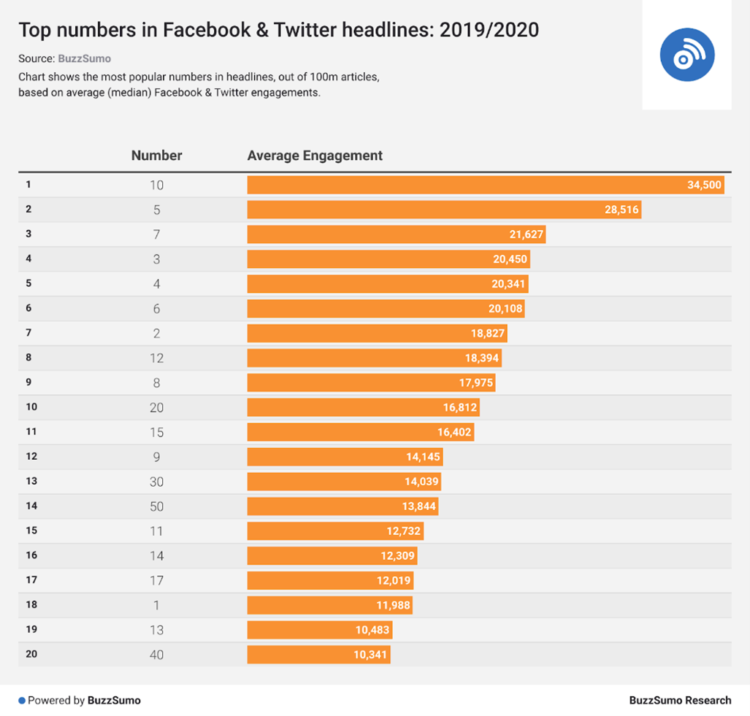
Even or odd?
It turns out that according to BuzzSumo’s research, it doesn’t really matter whether numbers are even or odd. The top five are 10, 5, 7, 3, and 4 – the battle between the even and odd numbers continues.
We want to read less
Another change is the shorter length of the “perfect title” – instead of 15 words and 95 characters, we have 11 words and 65 characters. So you need to be even more specific and capture everything your article is about in just 11 words!

See how the average engagement increases up to 11 words and then… drops rapidly.
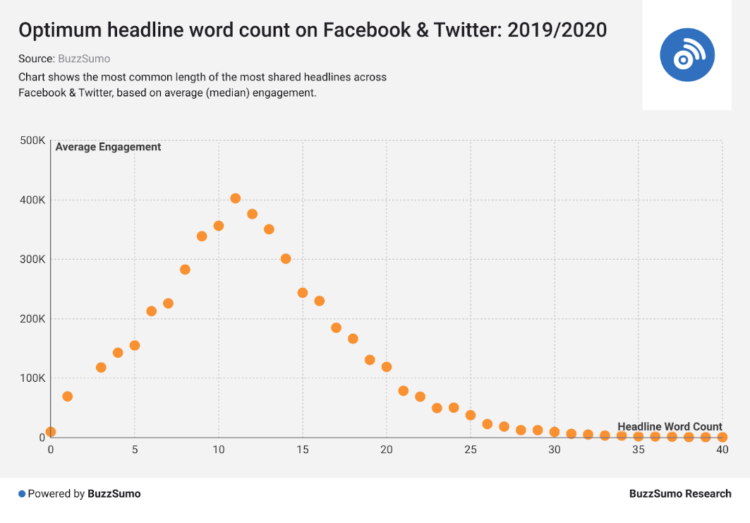
Nobody wants to spend all day online. There is no time for that. In fact, it’s becoming increasingly common for us to intentionally abstain from social media or the internet to take care of our health and well-being. That’s why, as a person who in some way designs the cyberspace where users spend their time, you can meet their needs: write concisely, precisely and intriguingly.
Which words to use?
In recent years, we could have observed a certain trend when it comes to the words that are used in articles and inspire user engagement.
- Of the year (e.g. the greatest discovery of this year – such phrases make us believe that something important is happening and we can’t miss it)
- In X years (e.g. the best book in 3 years)
- For the first time (e.g. this comet will appear near Earth for the first time in several hundred years)
- One of the (e.g. one of the best selling cars)
- How to make (e.g. how to make homemade soy candles) + analogical guide keywords: how to find, how to cook
- Of all time (e.g. the most comfortable heels of all time)
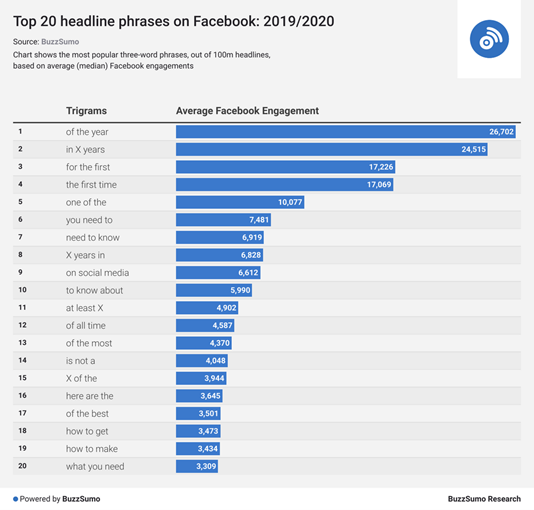
10 tips on how to write the title of an article
1. Take advantage of our love for numbers
People love numbers and specific amounts of information. These factors make users more likely to click your article. You’re here, so you probably know that in the end, it’s better to read about 10 specific tips on how to write the title of an article than to enter a vague text without any promises.
2. Emphasize the unique value you give to users
How can users profit from entering your website? Why should they even care about what you’ve written? Keep in mind that given pieces of content are related to your industry, not necessarily to the industry your readers operate in. Therefore, when looking at your title, you should be able to say what is special about your post: unique knowledge, news, great infographics?
3. Use memorable phrases
Replace common and repetitive adjectives (e.g., interesting, good, boring) with other words that appeal more to the emotions and imagination: after all, you’d rather learn the recipe for mouth-watering pralines than tasty chocolates, right?
4. Consider your target audience
Understanding your target audience is the key to creating catchy, and, more importantly, relevant titles. Determine who you’re writing to – what are the needs of your recipients? What language do they like? What do they expect, maybe they have requirements you could meet? Tailor-made article titles are the best option.
5. Address the recipient, speak directly
It’s good to speak directly to your audience – show what you have for them, why they should get involved in what you create, or how your content can affect them, or improve the quality of their lives.
For example: “Discover 7 books that will help you learn about your dog’s needs.”
6. Ask questions
Sometimes simple solutions work the best. Especially if you’re writing articles with specific keywords, but still want to attract users. Start your title with a question: “Does content still affect your position in Google?”
7. Come up with several titles before you choose the one
It’s really important to brainstorm on different titles. Create a new document, think about your article content and then come up with at least a few ideas to ensure that you have something to choose from.
8. Use keywords
It’s possible to create titles that are SEO and user-friendly. Frequently, you can create phrases that will help you improve your visibility in the SERPs, but will also attract users. It’s like killing two birds with one stone.
9. Don’t let your market rivals outdo you
Monitor your market rivals and determine which of their activities could help you refine your article titles. Use tools or manually go through your competitors’ sites. This might help you when you’re puzzling about how to write the title of an article.
10. Make a checklist and check if:
- The title offers a clear reward for clicking (knowledge, satisfaction, etc.)
- You can add something to make the title more believable/intriguing
- The title evokes emotions that will be followed by action (clicking, reading)
- The title is clear, specific, and easy to read
Catchy article titles – examples you should know (and use)
- Rankings with listings
- Hyperboles, all the “best” stuff
- Tutorials, guides
- Surprising facts and news
- Catchy titles
- Snapshots of unique stories
Now, you see, why it’s worth creating enticing titles.
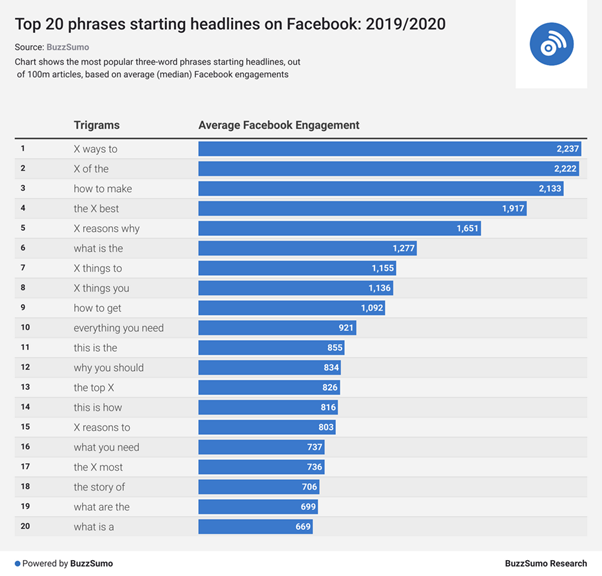
Don’ts when creating article titles
Hopefully, by now you know how to create catchy titles. However, there are also certain tempting practices you should definitely avoid, as they may have a negative impact on your brand image, bounce rate, and much more:
- Worthless promises. Don’t write about things that can’t be found in the text. This way, you’ll annoy users and your bounce rate will increase.
- Random titles. Remember that each header and title should be unique. Don’t use things that worked on other websites without thinking about your strategy. Apart from the context, it’s also important to analyze your target group and its needs.
- Don’t use cheap clickbaits. Keep the quality of your content high. Clickbaits may anger your audience and this won’t bring you any benefits.
Examples of quality article titles
If you’re looking for catchy article title ideas, the examples below will tell you how to implement our tips and increase your conversion rate.
- The title uses distinguishing words: “easy”, “instant”, “budget”;
- Numbering – “10 recipes”;
- Appropriate length – 10 words.
- Understatement – it’s not clear which bank is involved;
- Sense of urgency – “Watch out”; relevant information.
- Question – interesting, SEO-friendly (frequently typed phrase);
- Relates to something common (bread);
- Numbering – ten facts (*It would be better if it was a number – “10”, not “ten”).
Exercise for you: one article, 5 different titles
1. You’ve written an article, but you aren’t sure about the title? Great. Think about the content and describe it in up to 11 words, in a possibly neutral way. So, think about something like: “Pasta recipes with vegetables”.
2. This is your cornerstone. Now you can work with it, refine the title and come up with different versions:
- number (“10 pasta recipes with vegetables”)
- a question (“What are the pasta recipes with vegetables?”)
- a message to the addressee (“Pasta recipes with vegetables you must know”)
- a hint (“How to prepare pasta with vegetables?”)
3. Now you can refine your title. Users are most likely to click on a title with a number in it. But remember about other tips from the previous section: add words users will remember (in the case of food, this would be something that stimulates the taste buds), think about something that could differentiate your entry and keep it appropriately long.
4. Read the title you’ve created and think if it’s catchy enough. A finished product might sound like this: “How to make real Italian pasta with vegetables? Learn 10 tasty recipes.”
Last but not least, 5 pillars of a good article title
- Make the user need you – offer necessary information, help, or arouse curiosity.
- Create a certain sense of urgency; let the reader know that they shouldn’t wait and need to read the article.
- Assert that you are unique and original – no one else offers what you do (you can express this with specific knowledge, or being the “first” or reliable).
- Don’t repeat generic schemes that work for other audiences, but not yours. You’re the one who should know your target recipients and write for them – not for all 100 million people on the web!
- Be specific and sincere, and if you’re trying to attract attention, make sure that your title is refined.





